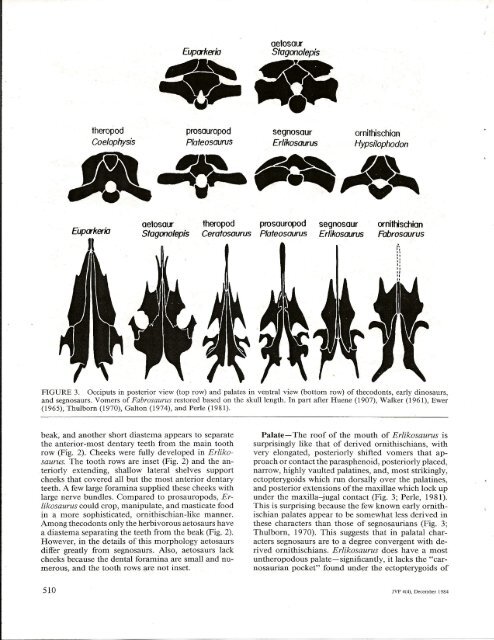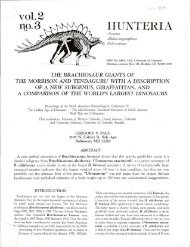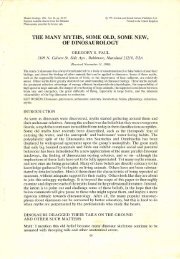THE SEGNOSAURIAN DINOSAURS: RELICS OF ... - Gregory S. Paul
THE SEGNOSAURIAN DINOSAURS: RELICS OF ... - Gregory S. Paul
THE SEGNOSAURIAN DINOSAURS: RELICS OF ... - Gregory S. Paul
You also want an ePaper? Increase the reach of your titles
YUMPU automatically turns print PDFs into web optimized ePapers that Google loves.
Euparkeria<br />
theropod<br />
Coelophysis<br />
aetosaur<br />
Eupa-keria Sfagonolepis<br />
.• c-<br />
aetosaur<br />
Sfagonolepis<br />
prosauropod<br />
Plateosaurus<br />
theropod<br />
Ceratosaurus<br />
segnosaur<br />
Erlikosaurus<br />
pro sauropod<br />
Plafeosaurus<br />
segnosaur<br />
Erlikosaurus<br />
ornifhischian<br />
Fabrosaurus<br />
FIGURE 3. Occiputs in posterior view (top row) and palates in ventral view (bottom row) of thecodonts, early dinosaurs,<br />
and segnosaurs. Vomers of Fabrosaurus restored based on the skull length. Iri part after Huene (1907), Walker (1961), Ewer<br />
(1965); Thulborn (1970), Galton (1974), and Perle (1981).<br />
beak, and another short diastema appears to separate<br />
the anterior-most dentary teeth from the main tooth<br />
row (Fig. 2). Cheeks were fully developed in Erlikosaurus.<br />
The tooth rows are inset (Fig. 2) and the anteriorly<br />
extending, shallow lateral shelves support<br />
cheeks that covered all but the most anterior dentary<br />
teeth. A few large foramina supplied these cheeks with<br />
large nerve bundles. Compared to pro sauropods, Erlikosaurus<br />
could crop, manipulate, and masticate food<br />
in a more sophisticated, ornithischian-like manner.<br />
Among thecodonts only the herbivorous aetosaurs have<br />
a diastema separating the teeth from the beak (Fig. 2).<br />
However, in the details of this morphology aetosaurs<br />
differ greatly from segnosaurs. Also, aetosaurs lack<br />
cheeks because the dental foramina are small and numerous,<br />
and the tooth rows are not inset.<br />
510<br />
Palate- The roof of the mouth of Erlikosaurus is<br />
surprisingly like that of derived ornithischians, with<br />
very elongated, posteriorly shifted vomers that approach<br />
or contact the parasphenoid, posteriorly placed,<br />
narrow, highly vaulted palatines, and, most strikingly,<br />
ectopterygoids which run dorsally over the palatines,<br />
and posterior extensions of the maxillae which lock up<br />
under the maxilla-jugal contact (Fig. 3; Perle, 1981).<br />
This is surprising because the few known early ornithischian<br />
palates appear to be somewhat less derived in<br />
these characters than those of segnosaurians (Fig. 3;<br />
Thulborn, 1970). This suggests that in palatal characters<br />
segnosaurs are to a degree convergent with derived<br />
ornithischians. Erlikosaurus does have a most<br />
untheropodous palate-significantly, it lacks the "carnosaurian<br />
pocket" found under the ectopterygoids of<br />
JVP 4(4), December 1984









